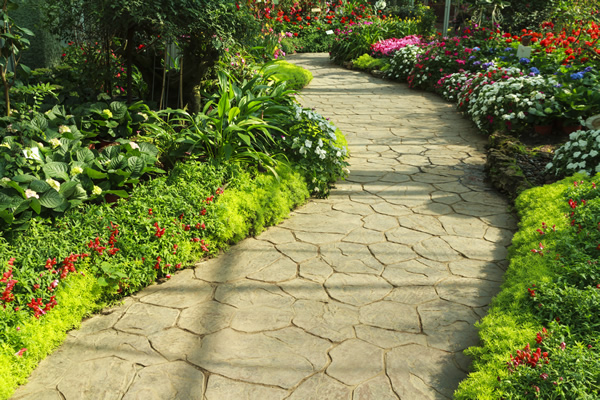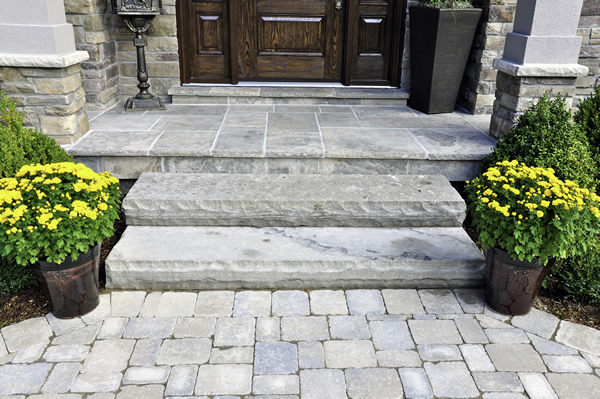A walkway is a wonderful addition to any home. It’s a great way to charm your guests, improve your property’s curb appeal, and add style to your front yard.
In fact, a well-built walkway can complement your landscaping and property. But, before you decide to build one, you should take the following factors into consideration:

1. Safety
When it comes to building a walkway at home, safety must be the first thing you should consider. You wouldn’t want any aspect of your walkway preventing you from seeing someone in front of your door because your guests are concerned about your walkway’s safety. To prevent this, add some lighting along your walkway. It not only helps you see clearly but also adds an inviting ambiance to your property.
You should also check out the building requirements for a walkway to avoid any inconvenience. By taking this precautionary step, you can ensure that your walkway is constructed based on the required building codes.
2. Budget
Another thing to consider when constructing a walkway is your finances. Because cost dictates what materials you may use, it’s crucial to set a budget for the project. Once you do this, you can avoid financial problems in the long run.
3. Materials
Choose materials that can withstand various weather conditions. It must also be appropriate for the place you’re living in. The best professionals can give you walkway recommendations regarding the materials suited for the terrain of your home. Depending on your preferences, you can make your walkway stylish by adding borders and accent bands or stone edging.
If you’re confused about what materials to consider, below are some of the popular options you can choose from for your walkway:
- Brick – It’s available in a variety of patterns and rich in colors. While it’s expensive to install, it has a huge impact on the resale value of your property.
- Once installed properly, it requires low maintenance and usually lasts a lifetime.
- Gravel – There are several benefits to using gravel as the material for your walkway. Aside from being affordable, it’s also easy to lay.
- If you choose a gravel walkway, you only need to determine where you want your walkway, lay down landscape fabric to prevent weeds, and pile on the gravel. But, to avoid gravel from spreading, you have to install a type of edging if you don’t have one yet.
- The most inexpensive choice is plastic edging, but you can use paving stones, bigger rocks, or brick pavers to contain the gravel.
- If possible, choose smaller gravel. It tends to be easier to walk on as they can be packed down together properly. If you’re laying a big gravel path, take the measurements to your gravel supplier to calculate how much you’ll need to buy. They’ll also save you from headaches by delivering your order.
- Pavers – It refers to a thin flat stone, which is used in paving products including driveways, walkways, and patios.
- Today, pavers are available in various styles. However, unlike other materials, they tend to cost more. The good thing about them is that they carry low maintenance costs and last longer.
- Natural Stone – It’s a great option for walkways because stones are available in unique colors, shapes, and designs. But, be prepared for a bit of maintenance because stones like slate may chip once exposed to too much moisture.
- If you really want to use natural stones for your walkway, a popular choice is flagstone, which can withstand extreme temperatures and is fairly durable. It’s also known for its slip-resistant finish, but it requires to be grouted in and set on mortar.
- Concrete – It’s a durable, cost-friendly, low-maintenance, and versatile material for a walkway, making it suitable for various terrain. No matter what your preferences are, you can keep a concrete walkway simple or you can elaborate it with texture and color.
- Unfortunately, concrete may crack over time. So, be sure to use concrete pavers if you want to consider stamped concrete to avoid that problem.
- Basalt Pavers – It’s an igneous rock that comes from the oceanic crust of the Earth, which is known for being durable, dense, and hard.
- The gray-to-black palette and rectilinear geometry make it a good complement for any contemporary home.
- Asphalt – It’s also a popular option for walkways. It can withstand freeze-thaw cycles and is pliable compared to pavers or concrete. However, this kind of material requires regular maintenance.
4. Property Value
A walkway creates an extension of your house by making use of the unutilized places. It can also boost your property value. When done correctly, a quality walkway that’s made with great materials is a wise investment.
On the other hand, a poorly built or planned walkway can lessen your home’s value. So, be sure to consult a landscape designer before you decide to build one at home. Landscape designers can tell you whether or not the project is worth the cost.

5. Scale
Your desired walkway must blend naturally with your house and shouldn’t stand out. Maintain a sense of scale by selecting the right materials for the look you want. Make sure that it’s wide enough for everyone to walk on but not too wide that it’s out of proportion to everything else in the environment.
6. Shade
The amount of shade in your property is another thing to consider when building a walkway because it’s an essential factor to choose what materials to use.
Mildew and moss can accumulate on concrete and stone, which can make them slippery and potentially hazardous. For walkways in shade, avoid using poured concrete and use pavers instead.
7. Home Construction
Before you build a walkway at home, consider the siding and colors of your house. If you want to mprove your home’s curb appeal by adding a walkway, try to choose a color that complements the existing structures. However, it doesn’t need to match them exactly.
For instance, if your house has a brick exterior, choose a tint found in the brick walls to include in your walkway. That’s the reason why earth tones are very popular as they complement traditional building materials.
Conclusion
Those are just some of the things you should consider when building a walkway at home. If you’re not sure how or where to get started, it’s always best to hire professionals to help you. Just make sure to hire the most reputable ones in the industry for you to get the best value for your investment.
